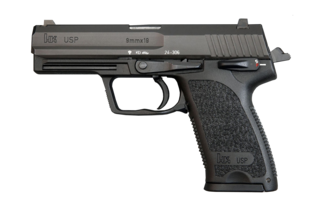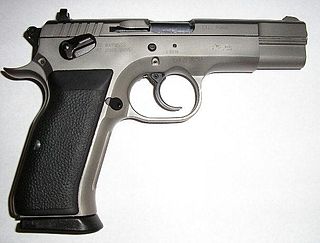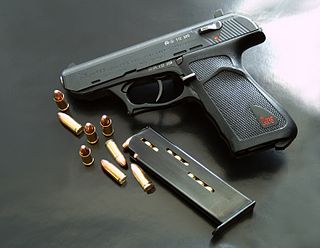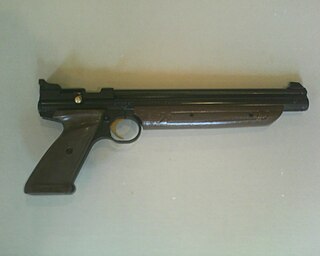
An air gun or airgun is a gun that using energy from compressed air or other gases that are mechanically pressurized and released as propellant for the chosen projectiles based on the principle of the primitive blowgun. This is in contrast to a firearm, which fires projectiles using energy by burning combustible propellants, most often gunpowder.
Airsoft, also known as survival game in Japan where it was first popularized, is a team-based shooting game in which participants eliminate opposing players out of play by tagging them with spherical plastic projectiles shot from low-power airguns called airsoft guns.
The Beretta 92G-SD and 96G-SD Special Duty handguns are semi-automatic, locked-breech delayed recoil-operated, double/single-action pistols, fitted with the heavy, wide Brigadier slide, chambered for the 9×19mm Parabellum cartridge (92G-SD) and the .40 S&W cartridge (96G-SD), framed with the addition of the tactical equipment rail, designed and manufactured by Beretta.

The Mannlicher M1894 was an early blow-forward semi-automatic pistol.

The USP is a semi-automatic pistol developed in Germany by Heckler & Koch GmbH (H&K) as a replacement for the P7 series of handguns.
Weihrauch & Weihrauch GmbH & Co. KG is a German manufacturer of target and sporting air rifles, air pistols, cartridge rifles and pistols. In North America, they are often distributed under the Beeman brand name.

The Beretta Px4 Storm is a semi-automatic pistol intended for personal defense and law enforcement use. It is available in full size, Compact, and Subcompact versions. The Px4 uses a trigger and safety system similar to the Beretta 92 and the Beretta 8000 series, though it is distinguished from its predecessors by its light-weight polymer construction with steel inserts, standard Picatinny rail, and swappable grip backstraps. The full size and Compact versions use the same short-recoil, rotating barrel action as the Beretta 8000 series, whereas the Subcompact uses the tilt barrel system.

The Steyr M is a series of semi-automatic pistols developed by Steyr Mannlicher GmbH & Co KG of Austria for police services and the civilian shooting market. Design work on the new pistol began in the early 1990s and the final product known as the M9 was officially unveiled in the spring of 1999. The M40 version chambered in .40 S&W was developed before the M9, followed later by the M357 and two smaller variants of the M9 and M40 designated the S9 and S40 respectively. These pistols were developed primarily for concealed carry and have a shortened barrel, slide, smaller frame and a reduced magazine capacity. In 2013, the Steyr M (Medium) and S (Small) form factors were complemented by the L (Large) sized series and the C (Compact) sized series both available in 9×19mm Parabellum and .40 S&W chamberings as the L9-A1, L40-A1, C9-A1 and C40-A1.
The BSA Scorpion Air Pistol was an air pistol made by the Birmingham Small Arms Company and first produced in 1973. It was a large, heavy, spring powered, single-shot weapon available in .177 (4.5 mm) and .22 (5.5 mm) calibers and was BSA's first air pistol. At 5.5 ft•lbf, it was close to the UK legal power limit for an air pistol.
Llama Firearms, officially known as Llama-Gabilondo y Cia SA, was a Spanish arms company founded in 1904 under the name Gabilondo and Urresti. Its headquarters were in Eibar in the Basque Country, Spain, but they also had workshops during different times in Elgoibar and Vitoria. The company manufactured moderate-priced revolvers and self-chambering pistols in a wide variety of models. These were popular mainly in the European and Latin American export market, as well as domestically in Spain.

The Benelli Kite is a single shot .177 inch calibre pre-charged pneumatic air pistol designed for the 10 m Air Pistol ISSF shooting event. It is manufactured by Benelli Armi SpA of Italy.

The Tanfoglio Combat or Standard, also known as T(A)95 or EAA Witness Steel, is a modified clone of the Czech CZ-75/CZ-85 pistol. It is made in Gardone Val Trompia near Brescia, Italy by Fratelli Tanfoglio S.N.C.
The Walther LGR air rifle was developed by the German arms manufacturer Carl Walther GmbH Sportwaffen as a high end match rifle for 10 metre air rifle competition shooting. The LGR was the first match air rifle that employed the then futuristic single-stroke pneumatic method as power source. This use of pre compressed air introduced the advantages of recoilless and vibration free shooting in combination with a well-made air rifle into the sport. It took other manufacturers a decade before they also introduced single-stroke pneumatic match air rifles.

The HK P9 is a semi-automatic pistol from Heckler & Koch in 9×19mm Parabellum, .45 ACP, and 7.65×21mm Parabellum and the first to use a variation of H&K's roller delayed blowback system in a pistol format and polygonal rifling now common in H&K designs.

The Crosman model 1322Medalist .22 Caliber Pellet Air Pistol was a single-shot, bolt-action loading, pneumatic pump-action .22-caliber air pistol, featuring a button-rifled 10.1-in. (256 mm) steel barrel and checkered plastic grips. The 1322 was introduced in 1977 by Crosman as a general-purpose air pistol for target practice and small game hunting. It was in production, in three separate manufacturing versions, until 2004, when it was discontinued from sale in the U.S.A. In 2012 the gun has been reintroduced by Crosman.

The Walther PPQ is a semi-automatic pistol developed by the German company Carl Walther GmbH Sportwaffen of Ulm for law enforcement, security forces and the civilian shooting market as a development of the Walther P99. It is available in 9×19mm Parabellum, 9×21mm, .40 S&W, and .45 ACP chamberings.
The BSA Mercury was a break barrel, spring powered, Air Rifle first produced in 1972 by the Birmingham Small Arms Company and then Gamo (UK) Limited. It was manufactured in .177 (4.5 mm) .22 (5.5 mm) and .25 (6.35 mm), the latter named the "635 Magnum". The Mercury was marketed between the BSA Meteor and AirSporter models and was a light, easy to use rifle, giving a "just under legal limit UK power" of 11.5 ft•lbf of energy.
The BSA Buccaneer was a break barrel spring powered air rifle first produced in 1977 by the Birmingham Small Arms Company, manufactured in both .177 (4.5 mm) and .22 (5.5 mm) calibers and marketed as an introduction air rifle for younger shooters with a muzzle energy of 5.5 ft•lbf. The rifle had a safety catch, which was disengaged by operation of a lever next to the shooter's thumb.
The Weihrauch HW 35 is a break barrel, spring-powered, air rifle first produced in 1951 by Weihrauch & Weihrauch located in Mellrichstadt, Bavaria. Available in 4,5 mm and 5,5 mm calibers, with standard and carbine (K) length barrels, it has been in continuous production since its launch, even though the Weihrauch HW 80 superseded it in the late 1990s.

The Weihrauch HW 77 is an underlever-cocked, spring-piston air rifle developed and manufactured by the German sporting weapons manufacturer Weihrauch. Renowned for its accuracy, the HW 77 is widely considered the most successful underlever air rifle ever made. It is also known for its rugged construction, considerable weight and precision adjustable trigger. The gun was marketed and sold as the Beeman HW 77 in the American market.











